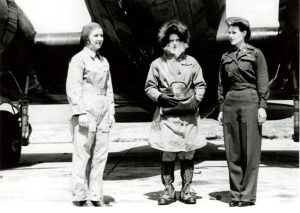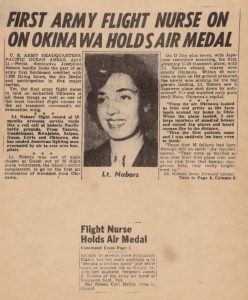Select Bibliography
Army Flight Nursing in World War II
Nonfiction
When writing Beyond the Call of Duty: Army Flight Nursing in World War II, I read extensively about the topic. Much has been written, both during and after the war, about the success of air evacuation as a means of transportation for sick and wounded soldiers of World War II and about the flight nurses who provided the patient care. These sources fall into several categories.
First are histories of air evacuation, often prepared by military personnel or historians, that mention the role of the flight nurse. “Air Evacuation: An Historical Review” by Frederick Guilford and Burton Soboroff (Journal of Aviation Medicine 1947), Medical Support of the Army Air Forces in World War II by Mae Link and Herbert Coleman (US Government Printing Office 1955), and Aeromedical Evacuation in the United States Air Force, 1909–1960 by Robert Futrell (USAF Historical Division, Research Studies Institute, Air University 1960) are three such examples. Although unpublished, academic theses and dissertations written by military scholars offer comprehensive insight into particular aspects of flight nurse history. Helen Rumianek’s “The Historical Development of the Flight Nurse Program in the United States Air Force Nurse Corps” (Catholic University, Washington DC 1965) and my own “The History of Flight Nursing in the United States Army Air Forces During World War II” (Catholic University, Washington DC 1977) and “Coping with War: An Oral History of United States Army Nurses Who Flew with the Army Air Forces in World War II” (University of Texas at Austin 1986) fall into this category.
Second are memoirs written by flight nurses. Nurses stationed overseas with medical air evacuation squadrons contributed accounts of their work to military and nursing journals during and immediately after their tours of duty. Henrietta Richardson’s “Flight Nurse” (Air Force 1943) and “Skyway Nursing” (American Journal of Nursing 1944) and Dorothy Rice’s “Flight to Kirawagi” (American Journal of Nursing 1945) represent these short descriptive articles. Many decades after the war, some World War II flight nurses published books about their military careers or about a memorable mission. Esther Baer Moseley’s Lady Don’t Stop Here (Publisher Unidentified 1980) recounts her adventures as a flight nurse evacuating wounded patients from China, Burma, and India. Dorothy Berendsen’s The Way It Was (Carlton 1988) looks back at her flight nurse assignment in Europe. Lucy Wilson Jopling’s Warrior in White (Watercress 1990) chronicles her experiences as a nurse in Bataan and on Corregidor and later as a flight nurse in the Pacific, where she helped evacuate from Luzon some of the liberated prisoners of war. Agnes Jensen Mangerich’s Albanian Escape (University Press of Kentucky 2000) is a carefully reconstructed account of a harrowing experience of escape and evasion behind enemy lines in Europe that she and others in her squadron endured after the plane in which they were flying had to make a forced landing. In The Story of Air Evacuation 1942–1989 (Taylor 1989), members of the World War II Flight Nurses Association submitted individual reminiscences to make up a collective history published in yearbook format. The work draws heavily on Wings Over America (1944), a previously published history of the Army Air Forces Troop Carrier Command at Bowman Field Army Air Base, Louisville, Kentucky, where flight nurses were trained.
Third are human interest stories about flight nurses, some written by war correspondents who accompanied these women on air evacuation missions, published in newspaper supplements and popular magazines. Often given a catchy title – “These Angels Fly on Man-Made Wings” (The Courier-Journal Roto-Magazine 1943), “Hell’s Angels” (Family Circle 1944), “Invasion Heroine: The Flying Nurse (Look 1944), “Angel Footprints” (Cosmopolitan 1944) – these stories feature numerous photographs of flight nurses at work.
Fourth are compilations of oral histories first appearing at the end of the twentieth century that include World War II flight nurses among their contributors. Tom Brokaw’s The Greatest Generation (Random House 2001), inspired in part by the author’s trips to Normandy on the fortieth and fiftieth anniversaries of D-Day, opened a floodgate of memories for men and women who had served in the armed forces in World War II and for their families back home. Overwhelming response to Brokaw’s book led to follow-on books containing letters and personal histories. Nurses feature prominently in resulting collections of interviews and reminiscences documenting women’s participation in the war effort. World War II flight nurses are among the contributors to Latter-Day Saint Nurses at War: A Story of Caring and Sacrifice (Brigham Young University 2005) compiled by Patricia Rushton, Lynn Callister, and Maile Wilson that spans World War I through Operation Iraqi Freedom. No Time for Fear: Voices of American Military Nurses in World War II (Michigan State University Press 1996) by Diane Fessler focuses exclusively on World War II and groups the short vignettes, some by flight nurses, by the various theaters of war.
And finally, World War II flight nurses were the heroines in books intended for young female readers beginning to consider the career options open to them after high school graduation. In the nonfiction Brave Nurse: True Stories of Heroism (Appleton-Century 1945), Ellsworth Newcomb included flight nurse Lieutenant Dorothy Shikoski, who attempted to assist a crewman when the plane in which they were traveling was forced to ditch in the seas of the South Pacific, among military nurses who demonstrated exceptional valor in time of war. Newcomb does not have his facts straight, however, concerning Shikowski’s flight nurse training and flight nurse wings. In Wyatt Blassingame’s Combat Nurses of World War II (Random House 1967), the Albanian experience of flight nurse Lieutenant Agnes Jensen is the focus of a chapter on flight nursing, which is factual in its detail because of input from the flight nurse herself.
More recently, Cate Lineberry’s Secret Mission: An Untold Story of American Nurses and Medics Behind Nazi Lines (Little, Brown 2013) retells the account of the downed air evacuation crew in Albania who made their way to Allied territory on foot over an arduous trek lasting months. I interviewed one of those nurses, Agnes Jensen Mangerich, and include her own account of the event in Beyond the Call of Duty.
To be continued



